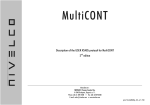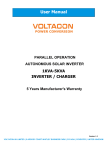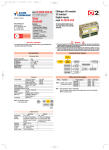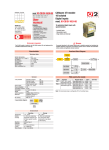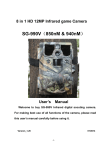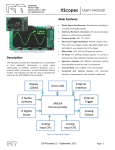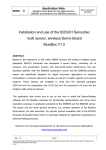Download 1771-6.5.14,Servo Interface Module User Manual
Transcript
AllenBradley Servo Interface Module (Cat. No. 1771-SF1) User Manual Table of Contents Introduction . . . . . . . . . . . . . . . . . . . . . . . . . . . . . . . . . . . . 11 Description . . . . . . . . . . . . . . . . . . . . . . . . . . . . . . . . . . . . . . . . User Considerations . . . . . . . . . . . . . . . . . . . . . . . . . . . . . . . . . . 11 12 Component Interfacing, Module Preparation, and Installation . . . . . . . . . . . . . . . . . . . . . . . . . . . . . . 21 General . . . . . . . . . . . . . . . . . . . . . . . . . . . . . . . . . . . . . . . . . . . Component Interfacing . . . . . . . . . . . . . . . . . . . . . . . . . . . . . . . . Encoder . . . . . . . . . . . . . . . . . . . . . . . . . . . . . . . . . . . . . . . . . . Differential Line Drivers . . . . . . . . . . . . . . . . . . . . . . . . . . . . . . . . Servo Drive Package . . . . . . . . . . . . . . . . . . . . . . . . . . . . . . . . . Isolation . . . . . . . . . . . . . . . . . . . . . . . . . . . . . . . . . . . . . . . . . . Wiring . . . . . . . . . . . . . . . . . . . . . . . . . . . . . . . . . . . . . . . . . . . . Cable Recommendations . . . . . . . . . . . . . . . . . . . . . . . . . . . . . . Shield Connection . . . . . . . . . . . . . . . . . . . . . . . . . . . . . . . . . . . Module Preparation . . . . . . . . . . . . . . . . . . . . . . . . . . . . . . . . . . Module Installation . . . . . . . . . . . . . . . . . . . . . . . . . . . . . . . . . . . Keying . . . . . . . . . . . . . . . . . . . . . . . . . . . . . . . . . . . . . . . . . . . Specifications . . . . . . . . . . . . . . . . . . . . . . . . . . . . . . . . . . . . . . 21 21 21 21 21 22 22 23 23 24 26 27 28 Programming and Operation . . . . . . . . . . . . . . . . . . . . . . . 31 General . . . . . . . . . . . . . . . . . . . . . . . . . . . . . . . . . . . . . . . . . . . Data Transfers . . . . . . . . . . . . . . . . . . . . . . . . . . . . . . . . . . . . . . DAC Data (Servo Motor Speed) . . . . . . . . . . . . . . . . . . . . . . . . . Control Byte (Servo Motor Amplifier Inhibit) . . . . . . . . . . . . . . . . . Encoder Counter Values (Position Pulses) . . . . . . . . . . . . . . . . . . Target Values (Position Interrupts) . . . . . . . . . . . . . . . . . . . . . . . . Special Servo Lines on the Backplane . . . . . . . . . . . . . . . . . . . . . Marker . . . . . . . . . . . . . . . . . . . . . . . . . . . . . . . . . . . . . . . . . . . A>B ............................................ CCW/CW . . . . . . . . . . . . . . . . . . . . . . . . . . . . . . . . . . . . . . . . . Target Value Interrupt . . . . . . . . . . . . . . . . . . . . . . . . . . . . . . . . . Programming the Servo Control Functions . . . . . . . . . . . . . . . . . . 31 31 31 33 34 34 34 35 35 35 35 35 Chapter 1 Introduction Description The Allen-Bradley Servo Interface Module (Cat. No. 1771-SF1) when used with the Micro Controller (Cat. No. 1771-UC1) can control single axis positioning systems such as found in machine tool applications. When combined with a single motor variable speed drive package and a full quadrature encoder, this microprocessor-controlled servo drive system (Figure 1.1) can be programmed to cycle through precise speed and position profiles. Figure 1.1 Typical MicroprocessorBased Servo Control System User Program EPROM Programming Unit Plug-in EPROM ÉÉ ÉÉ ÉÉ ÉÉ ÉÉ ÉÉ ÉÉ ÉÉ ÉÉ ÉÉ User Application Single-Motor Drive Package Amplifier Inhibit 1771UC1 Micro Controller 1771SF1 Servo Interface Module Controlled Power Motor Current Inhibit Velocity +- 10V Servo Amplifier Return Common Drive Shaft Servo Motor Tach. (Velocity Loop) Channels A & B, Channels A & B, Marker, Marker (Position Loop, 50KHz Max) Shaft Encoder Differential Line Driver 10399 11 Chapter 1 Introduction User Considerations 12 Operating features described in this manual must be totally programmed in the user software (Z-80A opcodes) of the accompanying micro controller. The servo interface module has the capability to perform as described, provided that the software of the micro controller has been completely developed. The user must assume full responsibility for performing all systems engineering, programming, and software support associated with the micro controller/servo interface module and intended application. Chapter 2 Component Interfacing, Module Preparation, and Installation General This chapter describes the necessary characteristics of user-provided components, preparation and installation of the module and wiring considerations. Refer to the Micro Controller Users Manual (Publication No. 1771-6.5.5) for installation of the micro controller module. Component Interfacing The servo interface module must be compatible with other components of the control system, including the differential line drivers, shaft encoder and servo drive package containing the servo motor control amplifier. Required characteristics of these components are stated below. Encoder An encoder should have the following characteristics for monitoring the rotational direction and position of a drive shaft. Full quadrature, 90o out of phase (typical). Maximum frequency to the servo interface module is 50 KHz for Channels A, B, and marker. Differential Line Drivers Line drivers with the following characteristics can be used to transmit encoder quadrature pulses to the servo interface module. Differential outputs for Channel A, Channel B, and marker. TTL Source and Sink Currents = 15 mA max. TTL Output Voltage = 2.4V (min.) high = 0.6V (max.) low Servo Drive Package Outputs available to the servo motor control amplifier must be compatible with the following control voltage and current levels. TTL output to inhibit the motor current. TTL output to turn OFF the servo drive amplifier. TTL Output Voltage = 2.4V (min.) high = 0.6V (max.) low TTL Sink Current = 12 mA (max.) 21 Chapter 2 Component Interfacing, Module Preparation, and Installation TTL Source Current = 7.9mA @ 2.4V +10 to -10V DC analog output for forward or reverse proportional motor speed control. Isolation None of the terminals of the servo interface module are protected against misapplication of AC, DC, or reverse DC. CAUTION: Do not apply voltage or current sources to the terminals of the servo interface module except those specified for the terminals. Damage to the module may result. If voltages are misapplied and damage is done to the terminal-side of the module, the system-side including the data bus to the micro controller is protected to 500V DC maximum isolation from the terminal side of the module. Wiring 22 The line drivers and the servo amplifier of the motor drive package should be wired to the field wiring arm connector of the servo interface module as shown in Figure 2.1. Chapter 2 Component Interfacing, Module Preparation, and Installation Figure 2.1 Typical Connection Diagram Servo Interface Module Field Wiring Arm Full Quadrature Encoder Channel A TTL Differential Line Driver Channel A Channel B Channel B Marker Marker 1 2 3 4 5 6 7 Drive Current Inhibit 8 Servo Amplifier 9 Amplifier On/Off 10 Analog Control, + 10V 11 Not Used 12 10401 Cable Recommendations The cable distance between the servo interface module and the differential line drivers should not exceed 40 feet. Use a twisted conductor pair within a shielded braid (Belden #8761 or equivalent) for connections to the line drivers. Use a 14 gauge conductor for the analog output to the servo amplifier and make this connection as short as possible to minimize the voltage drop in the cable. Shield Connection Belden 8761 or equivalent cable has a foil shield with a bare stranded drain wire. The shield should be connected to earth ground at one end of the cable only. This can be at the customer end of the cable or at an I/O chassis mounting bolt or stud. At the other end of the cable, the shield should be cut short and taped back to insulate it from any electrical contact. This is to guard against unwanted radiated electrical noise and ground current loops. 23 Chapter 2 Component Interfacing, Module Preparation, and Installation The common terminal of the servo interface module should not be used for the shield connection. This terminal is a common with respect to the analog output, TTL outputs and pull-up resistors on the differential inputs. WARNING: Do not use the common terminal of the servo interface module field wiring arm for the shield connection. Unpredictable operation could occur with resulting damage to equipment and/or injury to personnel. Module Preparation Prior to installation, the multiplication factor for counting the encoder quadrature pulses must be set internally. The quadrature pulses are transmitted through the differential line drivers to the terminals of Channels A and B. An additional complementary set of equal but logically opposite pulses are transmitted by the drivers to the terminals of Channel A and Channel B. The servo interface module can be set to count either 1, 2, or 4 of the quadrature pulse edges for each quadrature set depending on the desired positioning precision (Figure 2.2). The desired multiplier, x1, x2, or x4 can be set manually by inserting the pair of Burg pin jumpers on selected pairs of terminals. The jumpers are located on the printed circuit board inside the module. They are accessible by removing the cover plates according to the following procedure: Remove the four slotted screws from the label-side of the module. Remove the left and right cover plates. Place the printed circuit board on a table, solder side down. The pair of Burg pin jumpers are located in the center of the component-side of the printed circuit board and are identified by the labels JPR1 and JPR2. Position the jumpers according to Figure 2.3. 24 Chapter 2 Component Interfacing, Module Preparation, and Installation Figure 2.2 Example Encoder Diagram (250 Line) Encoder Output Channel A Channel B Counts Decoded on the Module X1 Marker Pulse at 360 o Quadrature Multiplier X2 X4 Single Encoder Line 250 Lines for one rotation (360o ) 10403 Figure 2.3 Burg Pin Jumper Selection Jumper Labels Jumper Setting for x1 Multiplier Jumper Positions JPR1 JPR2 Left 1 2 3 Right Encoder Count Multiplier JPR1 1 + 2 (left) JPR2 2 + 3 (right) x1 2 + 3 (right) 1 + 2 (left) x2 1 + 2 (left) 1 + 2 (left) x4 10402 25 Chapter 2 Component Interfacing, Module Preparation, and Installation Module Installation The module should be located in the I/O slot adjacent to the Micro Controller (Cat. No. 1771-UC1). If located further down the rack, propagation delays due to longer signal paths along the backplane could degrade performance. High-speed communication between the micro controller and servo interface module necessitates this location. The servo interface module must be used with the micro controller. It cannot operate with PC processors or adapters. The servo interface module can be used in the same I/O rack with any of the standard AC and DC 1771 I/O modules. However, it must not be used in an I/O rack containing microprocessor-based I/O modules. The only exceptions to this are the following microprocessor-based I/O modules which do not interfere with the operation of the servo interface module. 8-Bit Analog Input Module (Cat. No. 1771-1E) Encoder/Counter Module (Cat. No. 1771-IJ/IK) CAUTION: The Servo Interface Module (Cat. No. 1771-SF1) will operate only when paired with the Micro Controller (Cat. No. 1771-UC1). WARNING: Avoid placing microprocessor-based 1771 I/O modules (except as noted) in the same I/O rack with the servo interface module. Unpredictable operation could occur with resulting damage to equipment and/or injury to personnel. 26 Chapter 2 Component Interfacing, Module Preparation, and Installation Keying Plastic keying bands shipped with each I/O chassis provide an easy method for keying and I/O slot to accept only one type of module. Use of the keying bands is strongly recommended. The module is slotted in two places on its rear edge. The position of the keying bands on the backplane connector must correspond to the slots to allow insertion of the module so that only the servo interface module will fit in this slot. Refer to Figure 2.4. Snap the keying bands on the upper backplane connectors between these numbers printed on the backplane: 8 and 10 16 and 18 Needlenose pliers can be used to insert or remove keying bands. Figure 2.4 Keying Diagram First Backplane Connector For I/O Modules Keying Bands 2 4 6 8 10 12 14 16 18 20 22 24 26 28 30 32 34 36 2 4 6 8 10 12 14 16 18 20 22 24 26 28 30 32 34 36 First Backplane Connector For I/O Modules 27 Chapter 2 Component Interfacing, Module Preparation, and Installation Specifications Counter Input Analog Output (Single Channel to Servo Amplifier) • Differential • 10V to + 9.995V • Full quadrature encoder • 5mA to +5mA max. Counter Range Max. Cable Distance • 025510 • Marker input is latched and reset by user program. • 40 ft. encoder input • 40 ft. TTL output • 5 ft. analog output Max. Input Frequency Ambient Temperature Rating • 50 KHz, any channel • Operational : 0o to 60o C (32o to 140oF) • Storage : 40o to 85oC (40o to 185oF) TTL Input/Output Voltage • 0.6 V max. low voltage Relative Humidity Rating • 2.4 V min. high voltage • 5% to 9% (without condensation) TTL Input Current • 15mA per line driver channel (differential inputs only) TTL Output Current • 7.9mA @ 2.4V as source • 12mA max. as sink Number of TTL Outputs • Two 28 Chapter 3 Programming and Operation General The servo interface module controls the operation of a single motor servo drive package in accordance with commands received from the micro controller. Outputs to the servo amplifier of the drive package include: -10.000 to 9.995V analog output signal for proportional motor speed and direction control. A TTL output to limit the drive current from the servo amplifier to the motor. A TTL output signal to turn the servo amplifier ON or OFF. The servo interface module also monitors motion by counting quadrature pulses from a shaft encoder. The pulses represent the rotational position of the encoder shaft or servo motor drive shaft. The servo interface module sends an interrupt signal to the micro controller every time the accumulated counts of quadrature pulses equal a preset target value. This signal can be used to minimize the programming required to monitor and control the position of the drive shaft. Differential line drivers convert the single-ended encoder signal to differential pulses for Channels A, B, and Marker of the module. The driver also transmits a complement set of pulses (equal but logically opposite) to Channel A, Channel B, and Marker channel. Data Transfers All data transfers between the micro controller and the servo interface module take place over the normal I/O 8-bit data bus on the backplane of the 1771 I/O rack. The transfer of each one of the following data bytes is initiated by a separately addressed read or write instruction from the micro controller. The enable commands are transmitted over the special DSEN lines described in the Micro Controller User’s Manual (Publication No. 1771-6.5.5). DAC Data (Servo Motor Speed) The servo interface module contains a Digital to Analog Converter (DAC) that sends a 0 to +10V analog voltage to the servo amplifier of the motor drive package. The voltage controls the speed and rotational direction of the servo motor. The input to the DAC is a 12-bit binary number sent from the micro controller that allows the speed and rotational direction of the servo motor to be changed by user program. The DAC converts the 31 Chapter 3 Programming and Operation lower 11 bits to the 0 to 10V DC analog output. Bit 12 designates the sign + or - for forward or reverse motion. The resolution of the digital-to-analog conversion is +10V/2048 bits or approximately 4.883 mV/bit. Table 3.A shows the relationship between the input binary number from the micro controller and the analog output voltage from the servo interface module for sample values. The binary number for any desired output voltage can be determined as follows: POSITIVE OUTPUT 1. Output voltage (volts) ” decimal equivalent of the binary number. 4.883 x 10-3 (volts/bit) 2. Convert the decimal equivalent to the binary number. 3. Take the complement of the binary number. NEGATIVE OUTPUT 1. Output Voltage (volts) ” decimal equivalent of the binary number. 4.883 x 10-3 (volts/bit) 2. Convert the decimal equivalent to the binary number. 3. Add 1 bit to the binary number. Refer to the rpm/voltage chart provided by the servo motor manufacturer to complete the relationship between the DAC input binary number and servo motor speed and to determine the direction of rotation which is indicated by the sign bit. 32 Chapter 3 Programming and Operation Table 3.A DAC Input/Output Sign Bit Input Bit Pattern Analog Output Voltage 0 111 1111 1111 10.000V 0 111 1111 1110 9.995V 0 111 1111 1100 9.990V 0 000 0000 0011 19.5mV 0 000 0000 0010 14.6mV 0 000 0000 0001 9.7mV 0 000 0000 0000 4.9mV 1 111 1111 1111 0 1 111 1111 1110 +4.9mV 1 111 1111 1101 +9.7mV 1 111 1111 1100 +14.6mV (1) 1 000 0000 0011 +9.985V 1 000 0000 0001 +9.990V 000 0000 0000 (3) +9.995V 1 (2) (1) LowTRUE Bit Patterns (2)= MSBY (3) = LSBY The 12 bit binary input to the DAC is transferred to two bytes using two write instructions. The Most Significant BYte (MSBY) is eight bits long. It can be loaded into memory location 600EH. DSEN Line 16 enables the transfer. The Least Significant BYte (LSBY) can be loaded into memory location 600DH. It contains data in the upper 4 bits. The lower 4 bits are not used. DSEN line 15 enables the transfer. DAC data is reset at power-up or by the data byte reset command (write location 600BH). Control Byte (Servo Motor Amplifier Inhibit) Bit 2 of the control byte is used to inhibit amplifier drive current to the servo motor. Bit 3 is used to turn OFF the servo motor amplifier. They are low = TRUE optically isolated TTL outputs. 33 Chapter 3 Programming and Operation A write instruction to memory location 600FH latches these bits. DSEN Line 17 enables the transfer from the servo interface module. The control byte is reset at power-up or whenever the data byte reset command is programmed. Encoder Counter Values (Position Pulses) The encoder line drivers generate pulses for each encoder line. Assume that a 250 line encoder is used as in Figure 2.2. When the quadrature multiplier is x1, a counter increment of 1 means that the encoder shaft has turned through 1.44o. (This can be translated into the linear movement of a feed slide, proportional to the number of drive shaft threads per inch.) When either the x2 or x4 quadrature multiplier is used, one count is equivalent to a turn of .72o or .36o, respectively. The micro controller can be programmed to read the accumulated value of the encoder counters in the servo interface module by a read instruction from memory location 6008H. A read from the encoder counters is usually performed when the encoder is halted or turning very slowly. A read from this location does not halt counter operation. DSEN Line 10 enables the transfer from the servo interface module. The encoder accumulated value is set to zero at power-up and after 255 counts. It also can be set to zero by the counter reset command which is a write to location 6009H. Target Values (Position Interrupts) The target value determines at which count (in the accumulated count of encoder pulses) an interrupt will be sent to the micro controller. The target value is an 8-bit comparator preset ranging from 0-255. Target value interrupts can be counted to monitor and control the rotational position of the drive shaft. A write instruction to memory location 600CH latches the target value. DSEN Line 14 enables the transfer from the micro controller to the servo interface module. The target value preset is reset to zero at power-up or by the data byte reset command (write location 600BH). Special Servo Lines on the Backplane 34 Four special backplane lines are used to monitor servo signals at the micro controller. The first three lines transmit the marker, A>B, and CCW/CW signals, respectively, to the status port of the micro controller. They are read at memory address 7000H. These signals are always on-line. The fourth line transmits the interrupts to the micro controller. Chapter 3 Programming and Operation Marker A low = TRUE signal is transmitted to status port bit 0 after the marker signal is latched by the servo interface module for each completed revolution of the encoder shaft. A write instruction to 600AH will reset this latched output. A>B A low = TRUE signal appears at status port bit 1 whenever the target value (preset) is greater than the accumulated value of the counters counting the encoder pulses. The bit goes high when the accumulated value becomes equal to or greater than the target value. CCW/CW Generally, a low signal appears at status port bit 2 when the rotation of the encoder shaft is counterclockwise (CCW). A high signal will then indicate clockwise (CW) rotation. This relationship depends on system hardware and/or wiring polarity. Target Value Interrupt Whenever the accumulated value of the encoder counter becomes equal to the target value preset, an interrupt signal is sent to the micro controller. The vectored interrupt is generated by the counter/timer circuit (CTC Channel 2) in the micro controller. The interrupt condition is automatically reset by the micro controller during execution of the return from interrupt instruction (RETI). The micro controller must be programmed to perform this function. Programming the Servo Control Functions The servo interface module controls the drive package in accordance with commands received from the micro controller module. All programming of the micro controller is written in the Z-80 instruction set. In order to transfer the information described in Paragraph 3.1 from or to the servo interface module, certain memory addresses have to be accessed in the micro controller. Whenever a Z-80 instruction is written to or read from a control function address for the servo interface module, the instruction will force low one of the corresponding special enable lines, DSEN 10-17. This signal instructs the servo interface module to latch data received from the 8-bit bidirectional backplane data bus (system write) or to place data on the data bus (system read). The control functions, their addresses and corresponding DSEN lines are tabulated in Table 3.B. 35 Chapter 3 Programming and Operation Table 3.B Servo Control Features Control Function Memory Address DSEN Line Comments DAC Data, MSBY 600EH Write 16 8bit byte DAC Data, LSBY 600DH Write 15 Upper 4 bits of byte Target Value Preset 600CH Write 14 025510 in binary Control Byte 600FH Write 17 Bit 2 limits drive current . Bit 3 turns OFF the servo amplifier. Data Byte Reset Command 600BH Write 13 Resets DAC data, Target Value Preset and Control Byte by loading zeros (Also reset at powerup) Read Counter Accum Value 6008H Read 10 025510 in binary Counter Reset 6009H Write 11 Resets counters and decoder logic by loading zeros (Also reset at powerup). Marker Latch Reset 600AH Write 12 Resets the Marker Latch Refer to the Micro Controller Users Manual (Publication No. 17716.5.5) for additional information on developing the program to perform the various functions of the servo interface module. 36 AllenBradley, a Rockwell Automation Business, has been helping its customers improve pro ductivity and quality for more than 90 years. We design, manufacture and support a broad range of automation products worldwide. They include logic processors, power and motion control devices, operator interfaces, sensors and a variety of software. Rockwell is one of the worlds leading technology companies. Worldwide representation. Argentina • Australia • Austria • Bahrain • Belgium • Brazil • Bulgaria • Canada • Chile • China, PRC • Colombia • Costa Rica • Croatia • Cyprus • Czech Republic • Denmark • Ecuador • Egypt • El Salvador • Finland • France • Germany • Greece • Guatemala • Honduras • Hong Kong • Hungary • Iceland • India • Indonesia • Ireland • Israel • Italy • Jamaica • Japan • Jordan • Korea • Kuwait • Lebanon • Malaysia • Mexico • Netherlands • New Zealand • Norway • Pakistan • Peru • Philippines • Poland • Portugal • Puerto Rico • Qatar • Romania • RussiaCIS • Saudi Arabia • Singapore • Slovakia • Slovenia • South Africa, Republic • Spain • Sweden • Switzerland • Taiwan • Thailand • Turkey • United Arab Emirates • United Kingdom • United States • Uruguay • Venezuela • Yugoslavia AllenBradley Headquarters, 1201 South Second Street, Milwaukee, WI 53204 USA, Tel: (1) 414 3822000 Fax: (1) 414 3824444 Publication 1771-6.5.14 - February, 1983 Supersedes 1771-821 - September, 1983 PN 955089-98A Copyright 1986 AllenBradley Company, Inc. Printed in USA Publication 1771-6.5.14 - February, 1983



















